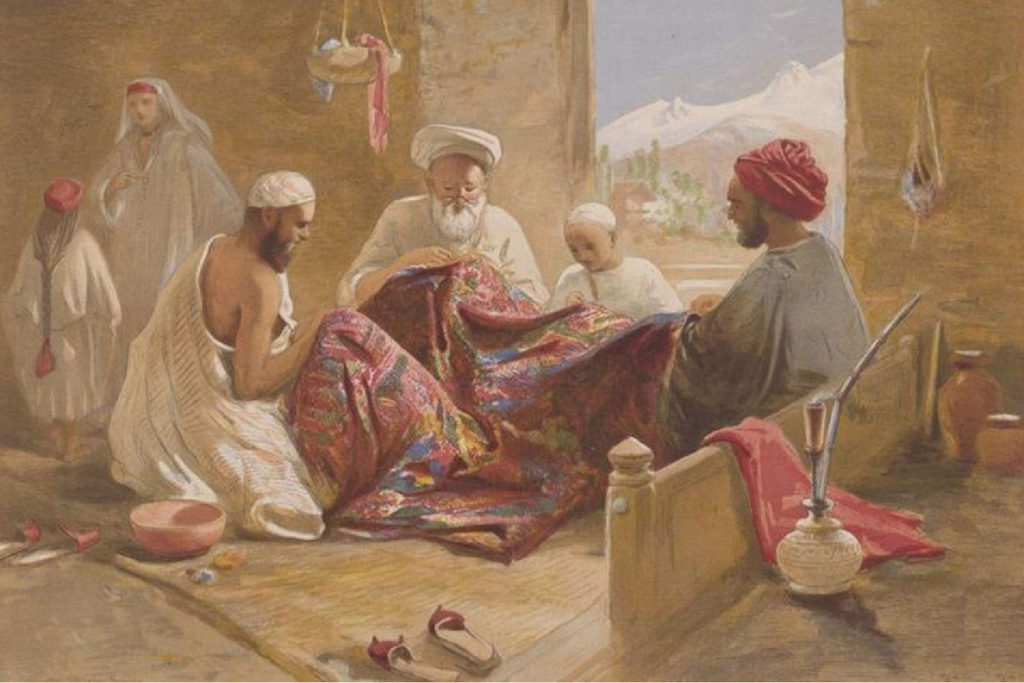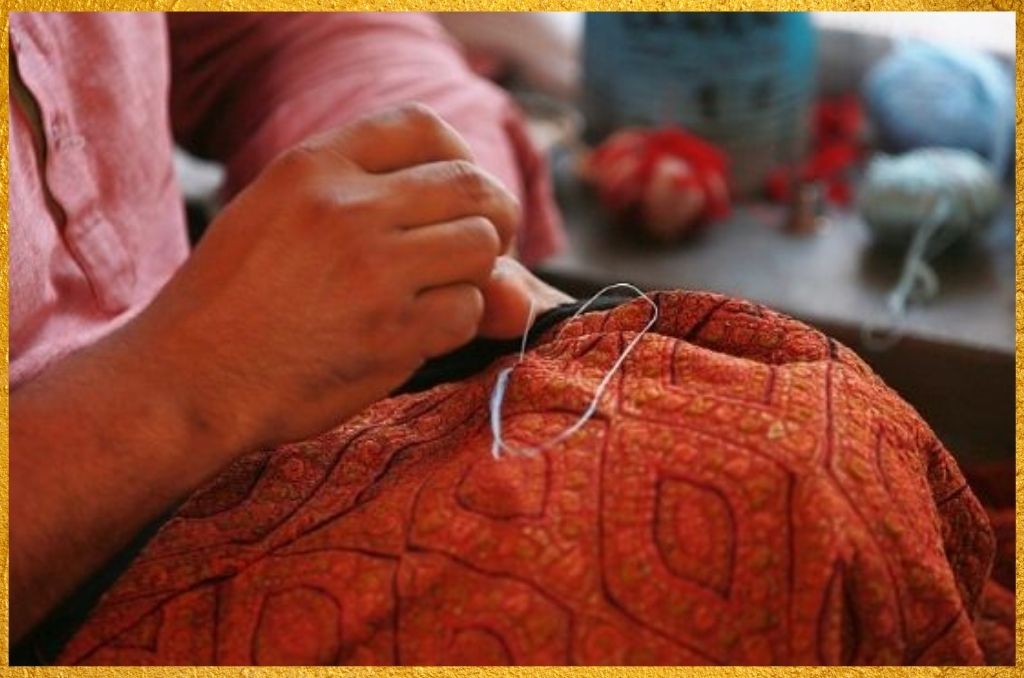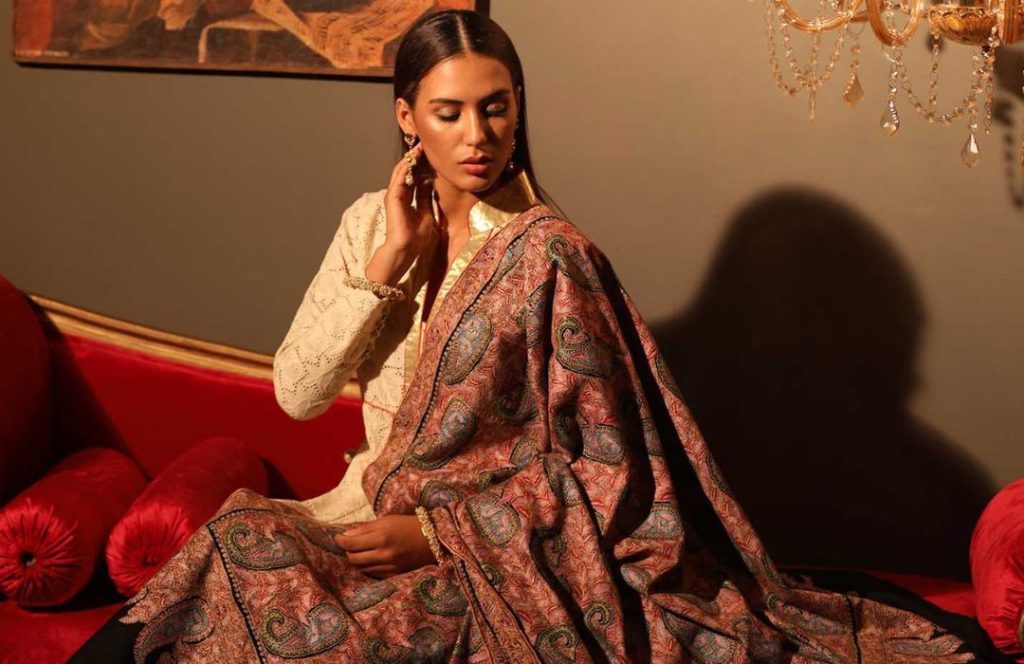In the enchanting valleys of Kashmir, the air is laden with the aroma of saffron. Further, the landscapes echo tales of timeless traditions. And here emerges a jewel in the crown of textile artistry – Kashmiri Sozni embroidery. This intricate craft has deep roots in the cultural heritage of the region. It weaves a narrative that transcends time, hence resonating with the artistry of skilled hands and the soul of a vibrant community.
What is Sozni?
Sozni, derived from the Persian word "suzan," meaning needle, is a centuries-old embroidery technique. It has graced the textiles of Kashmir for generations. As we embark on this exploration of Sozni embroidery, we unravel the threads of a tradition that has weathered the epochs, thus reflecting the resilience and artistry of a people.
In the heart of Srinagar, the capital city of Jammu and Kashmir lies the cradle of Sozni craftsmanship. Passed down through generations, this delicate form of needlework involves a meticulous process of hand embroidery that indeed renders life to fabric. Each stitch is indeed a testament to the patience and skill of the artisan. Additionally, Sozni's ornated pieces tell stories that go beyond the mere embellishment of cloth.
Kashmiri Sozni embroidery is not just a craft, but a cultural emblem. It embodies the spirit of the valley and the aesthetic sensibilities of its people. The artisans, often work in small ateliers or even at the cozy corners of their homes. There, they infuse their creations with a piece of their soul. The result is not just an embroidered fabric but a canvas of emotions. Sozni shawls are a manifestation of artistic expression and a repository of cultural identity.
As we immerse ourselves in the exquisite world of Sozni embroidery, we uncover the history that breathes life into this art. Also, we explore the techniques that make it unique and unravel the symbolism embedded in its motifs. Further, we witness the evolution of Sozni from its traditional roots to its contemporary adaptations. Join us on this journey, where every stitch tells a story. It is a story of the vibrancy of Kashmiri culture that unfolds through the delicate dance of the needle and thread.
History of Sozni
Kashmiri Sozni embroidery is a timeless craft that patrons celebrate for its exquisite artistry. It has deep-rooted historical origins that indeed echoes the rich cultural tapestry of the Kashmir Valley. This intricate needlework has flourished over centuries, thus blending influences from diverse historical periods, rulers, and cultural exchanges.
The history of Sozni embroidery in Kashmir dates back to ancient times. It has deep roots in the region's diverse cultural heritage. The craft gained prominence under different rulers who recognized the significance of preserving as well as enhancing Kashmir's artistic traditions. As early as the 14th century, during the rule of Sultan Zain-ul-Abidin, also known as Budshah, the foundations for the flourishing of crafts like Sozni embroidery were laid.
Sozni under various rules
During the Mughal era in the 15th century, Kashmir experienced a cultural renaissance. This further enriched the art of Sozni embroidery. The Mughal emperors, particularly Akbar, were patrons of the arts. Hence, their influence significantly shaped the development of various crafts in the region. Sozni embroidery, with its delicate and intricate patterns, became a symbol of sophistication and luxury during this period.

The 19th century witnessed the advent of the Sikh rule in Kashmir. And, under the reign of Maharaja Ranbir Singh, Sozni embroidery continued to thrive. The Maharaja's keen interest in promoting Kashmiri arts, hence, led to the establishment of workshops and ateliers dedicated to the craft. This further ensured its continuity.
The craft faced challenges during the Dogra rule in the late 19th and early 20th centuries. But the resilient spirit of Kashmiri artisans still prevailed. Despite changes in political landscapes and ruling powers, Sozni embroidery persisted, adapting to evolving tastes and preferences.
The intricate detailing and fine craftsmanship of Sozni embroidery were also influenced by Persian and Central Asian designs. The delicate motifs and patterns were woven with threads of silk, hence, adding to the luxurious appeal of the embroidered pieces.
In the latter part of the 20th century and into the 21st century, Sozni embroidery continued to evolve. Artisans embraced contemporary designs while preserving traditional techniques. This ensured that this historical craft remains a living testament to Kashmir's rich cultural legacy.
The Intricate Craftsmanship

Sozni embroidery, renowned for its intricacy and finesse, involves a series of meticulous techniques and craftsmanship. These have been honed over generations. The process of creating Sozni masterpieces is a testament to the skill and dedication of Kashmiri artisans.
Fine Thread Preparation
The foundation of Sozni embroidery lies in the preparation of exceptionally fine threads. Artisans carefully choose the raw material, often Pashmina, hence ensuring it meets the highest standards of quality. They meticulously process the threads to achieve the desired fineness. Note that this is a crucial step that sets the stage for the detailed embroidery work.
Tracing the Design
Once the threads are ready, the artisan begins by tracing the intricate design onto the fabric. Traditionally, this was done freehand without any prior drawing on the fabric, showcasing the artisan's immense skill and experience. However, in contemporary practices, artisans may use stencils or patterns to ensure precision.
More Embellishments
Tilla, or metallic threads, are often incorporated into Sozni embroidery to add a touch of opulence. These threads, typically made of gold or silver, are meticulously intertwined with the Pashmina threads. Tilla work enhances the overall texture and visual appeal of the embroidery, creating a luxurious finish.
Color Blending
A distinctive feature of Sozni embroidery is the artful blending of colors. Artisans carefully select a palette that complements the base fabric, thus creating a harmonious and visually captivating composition. The subtle transitions between colors add depth and nuance to the embroidered motifs.
Needle Selection
The choice of needles is critical in Sozni embroidery. Artisans use fine, pointed needles that allow for precise stitching, hence ensuring that the threads seamlessly integrate into the fabric. The delicate nature of the craft demands a high level of expertise in maneuvering the needle to achieve intricate patterns.
Time-Consuming Precision
One of the hallmarks of Sozni embroidery is the time-intensive nature of the craft. The level of detail and precision involved means that creating a single piece can take months or even years, depending on the complexity of the design. Artisans execute each stitch with care and deliberation, hence reflecting their commitment to perfection.
In essence, Sozni embroidery is a symphony of meticulous techniques and craftsmanship, where the hands of skilled artisans bring to life the rich cultural heritage of Kashmir. The result is not just an embroidered piece but a masterpiece that stands as a testament to the artistic legacy passed down through generations.
Motifs and Symbolism

The rich tapestry of Sozni embroidery is adorned with an array of motifs. Each carries its symbolic significance deeply rooted in the cultural heritage of Kashmir. These intricate patterns not only showcase the skill of the artisans but also convey stories, beliefs, and traditions unique to the region.
Paisley (Kairi)
The timeless paisley motif, known as "Kairi" in Sozni embroidery, is a symbol of fertility and eternity. Representing the shoot of a mango, a sacred fruit in Kashmir, this motif embodies the concept of prosperity and continuity. Its graceful curves and intricate details make it a cornerstone in many Sozni designs.
Chinar Leaf
The Chinar leaf motif, inspired by the majestic Chinar trees that dot the landscape of Kashmir, is a symbol of endurance and resilience. Often featured in Sozni embroidery, the Chinar leaf reflects the deep connection between nature and the artistic expression of the artisans. Truly, its presence in embroidered pieces pays homage to the region's scenic beauty.
Shikara (Boat)
The Shikara, or boat motif, is a nod to the iconic wooden boats that gracefully glide on the Dal Lake. Beyond its aesthetic appeal, the Shikara motif carries symbolic weight, hence representing the daily life, trade, and tourism that revolve around the picturesque lakes of Kashmir. Incorporating the Shikara into Sozni designs pays homage to the region's unique identity.
Eternity Knot (Yali)
The Eternity Knot, also known as "Yali" in Sozni embroidery, symbolizes continuity and eternal bonds. This intricate motif, featuring interwoven lines and loops, represents the interconnectedness of life and the enduring nature of relationships. Its presence in embroidered pieces adds a layer of meaning and cultural depth.
Jamawar Patterns
The inclusion of Jamawar patterns in Sozni embroidery reflects a fusion of cultures. Jamawar, originally a Persian art form, often features intricate floral and paisley motifs that spread all over the base. In Sozni, these patterns are adapted, thus contributing to a visual tapestry that transcends geographical boundaries.
Cultural Significance of Sozni
Sozni embroidery stands as an exquisite testament to the cultural richness of Kashmir, woven into the very fabric of the region's identity. Its significance goes beyond being a mere embellishment. It is a cultural phenomenon deeply embedded in the traditions and heritage of Kashmir.
Traditional Attire
One of the most striking aspects of Sozni embroidery is its integral role in traditional Kashmiri attire. The intricate patterns grace the fabric of traditional outfits like Pherans and Shawls, thus turning them into canvases that depict the artistry and cultural depth of the region. Sozni-embroidered garments are not just articles of clothing but symbols of Kashmiri identity, worn with pride and passed down through generations.
Ceremonial Importance
Sozni embroidery plays a crucial role in various ceremonies and celebrations in Kashmir. From weddings to religious festivals, Sozni-embellished garments are often donned as a mark of respect for tradition and a celebration of cultural identity. The meticulous craftsmanship and symbolic motifs contribute to the grandeur of these occasions, creating a visual spectacle that reflects the cultural values of the Kashmiri people.
Symbol of Heritage
In Kashmir, Sozni embroidery is more than a craft; it is a living heritage passed down through centuries. The art form reflects the region's resilience and cultural continuity despite the passage of time and changing influences. Sozni-embroidered textiles are cherished heirlooms, treasured for their beauty, craftsmanship, and the stories they carry. Families take pride in preserving and passing on these exquisite pieces, contributing to the preservation of Kashmir's cultural legacy.
Identity and Expression
Sozni embroidery serves as a unique form of self-expression and identity for the people of Kashmir. The motifs, patterns, and colors used in Sozni designs often carry specific meanings and cultural connotations. Wearing Sozni-embroidered clothing becomes a way for individuals to express their connection to Kashmir's rich cultural tapestry. Further, patrons can showcase their identity in a visually captivating manner.
Economic Empowerment
Beyond its cultural significance, Sozni embroidery also plays a crucial role in the economic landscape of Kashmir. Many artisans and craftsmen rely on Sozni embroidery as a source of livelihood. The craft's demand in the global market contributes not only to the economic empowerment of individual artisans and communities but also to the promotion of Kashmiri culture on an international stage.
In essence, Sozni embroidery is a living art form that weaves together threads of tradition, identity, and economic sustenance. Its cultural significance is not confined to the past; it continues to evolve and adapt, remaining a vibrant symbol of Kashmiri heritage in the contemporary world.
The Resurgence of Sozni Embroidery
As the world of fashion constantly evolves, traditional art forms find new life through contemporary adaptations. Sozni embroidery, deeply rooted in the cultural tapestry of Kashmir, has experienced a remarkable resurgence in modern fashion. Its intricate patterns and timeless allure have transcended the boundaries of tradition, thus making it a sought-after element on global runways and in collaborations with avant-garde designers.
Runway Renaissance
The intricate beauty of Sozni embroidery has gracefully made its way onto international runways, capturing the attention of designers and fashion enthusiasts alike. Renowned fashion houses have embraced Sozni-embellished ensembles, turning them into statement pieces that redefine the intersection of tradition and modernity. Delicate stitches as well as symbolic motifs have become a canvas for designers to showcase the richness of Kashmiri craftsmanship to a global audience.
Collaborations with Modern Designers
Sozni embroidery's journey into contemporary fashion is marked by collaborations with modern designers who appreciate its cultural significance. These collaborations serve as a bridge between tradition and innovation, bringing Sozni to new heights of visibility. Designers are incorporating Sozni-embroidered elements into diverse collections, from haute couture to ready-to-wear, hence adding a touch of Kashmiri elegance to the global fashion scene.
Global Fashion Landscape
Sozni embroidery has not only found a place on runways but has also become a sought-after choice for fashion enthusiasts worldwide. Its intricate patterns and cultural depth resonate with those who seek garments that tell a story. Sozni-embellished pieces have become coveted additions to wardrobes. Hence, these symbolize a connection to the rich heritage of Kashmir while making a distinctive fashion statement.
Innovations in Design
Contemporary adaptations of Sozni embroidery often involve innovative design approaches. Designers experiment with new color palettes, unconventional motifs, and unique garment silhouettes to infuse a breath of fresh air into this traditional craft. The adaptability of Sozni embroidery allows it to seamlessly blend with modern aesthetics, thus making it a versatile choice for various fashion expressions.
Cultural Fusion
Sozni's global journey involves a beautiful fusion of cultures. Designers from different parts of the world are incorporating Sozni embroidery into their creations, thus creating a harmonious blend of traditional Kashmiri artistry and diverse global influences. This cultural fusion not only breathes new life into Sozni but also fosters cross-cultural appreciation and understanding.
Therefore, the contemporary adaptation of Sozni embroidery marks a splendid chapter in the ongoing narrative of Kashmiri craftsmanship. Its presence on runways, collaborations with modern designers, and integration into the global fashion landscape showcase the enduring allure of this traditional art form. Sozni embroidery, far from being confined to the pages of history, continues to evolve and captivate the world with its timeless beauty and cultural depth.
Preservation: Safeguarding the Artistry of Sozni Embroidery
In the face of changing times and evolving fashion landscapes, the need to preserve traditional art forms becomes paramount. Sozni embroidery, deeply embedded in Kashmir's cultural identity, has garnered attention from preservation initiatives, workshops, and institutions aiming to safeguard this intricate craft.
Artisan Empowerment Workshops
One of the pillars of preserving Sozni embroidery lies in empowering the artisans who carry the legacy of this craft. Artisan empowerment workshops provide a platform for skilled craftsmen to enhance their techniques, learn new skills, and adapt to contemporary demands. These workshops also serve as spaces for knowledge exchange, where older artisans share their expertise with the younger generation, ensuring a seamless transmission of skills.
Institutional Support
Several institutions in Kashmir and beyond are actively involved in preserving and promoting Sozni embroidery. These institutions play a pivotal role in providing financial support, organizing training programs, and creating market linkages for artisans. By recognizing the cultural significance of Sozni, these institutions contribute to the sustainability of this traditional craft.
Government Initiatives
Government initiatives at both regional and national levels have been instrumental in the preservation of Sozni embroidery. These initiatives focus on creating favorable policy environments, offering financial assistance to artisans, and organizing events that showcase Sozni's cultural richness. By integrating Sozni into broader cultural preservation efforts, governments contribute to ensuring its continued relevance.
Documentation and Archiving
Preserving the heritage of Sozni embroidery involves documenting its history, techniques, and motifs. Archiving this information ensures that future generations have access to a comprehensive record of the craft. Documentation efforts include creating catalogs, recording oral histories of artisans, and establishing digital archives, contributing to the educational aspect of Sozni preservation.
Educational Programs
Educational programs focused on Sozni embroidery play a crucial role in nurturing a new generation of artisans. Workshops, seminars, and skill development programs create a conducive environment for young enthusiasts to explore and engage with Sozni embroidery.
Also read: PASHMINA: THE GIFT WE WANT TO RECEIVE IN 2024
Conclusion: Nurturing Kashmiri Sozni Embroidery
In the tapestry of cultural heritage, Kashmiri Sozni embroidery stands as a delicate thread connecting generations and narrating stories of tradition, skill, and identity. As we've delved into the historical roots, techniques, motifs, and contemporary adaptations of Sozni, one can't help but marvel at the resilience and timelessness of this art form.
The historical journey of Sozni embroidery is nothing short of a captivating narrative, intertwining with the grandeur of Mughal courts and the rich cultural fabric of Kashmir. From its inception, Sozni has been a silent witness to the changing epochs, adapting and flourishing in response to the artistic demands of each era.
The exploration of Sozni's techniques unveils the meticulous craftsmanship involved in every stitch. The delicate preparation of fine threads and the rhythmic dance of the needle are not merely acts of creation; they are an expression of centuries-old skill passed down through generations. The intricacy woven into each piece is a testament to the artisan's dedication and the profound connection between hand and craft.
The motifs embroidered onto Sozni's creations are not merely designs; they are cultural signifiers, each carrying a story, a belief, or a reflection of nature's beauty. From the chinar leaves to the paisley patterns, every motif contributes to the rich tapestry of Kashmiri artistry, speaking a language that transcends words. Sozni embroidery is not just an embellishment; it's a cultural emblem deeply rooted in the identity of Kashmir. Its significance in traditional clothing, ceremonies, and daily life solidifies its place as more than a craft—it's a living heritage that breathes life into every piece it adorns.
Also read: PASHMINA CLASSICS VS. CONTEMPORARY TWISTS: FINDING YOUR STYLE